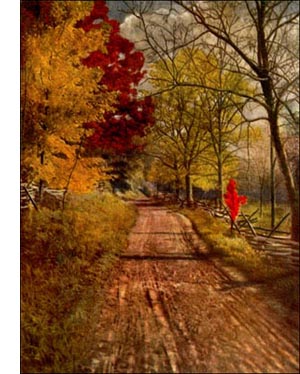Striped Maple or Moosewood Tree
 The Striped Maple, or Moosewood (Acer Pennsylvanicum, Linn,) grows from a shrub to a tree 40 feet high, best always in the shade of taller trees and usually in rocky woods that cover mountain slopes.
The Striped Maple, or Moosewood (Acer Pennsylvanicum, Linn,) grows from a shrub to a tree 40 feet high, best always in the shade of taller trees and usually in rocky woods that cover mountain slopes. It has green bark that breaks as the stems increase in diameter into a network of furrows, which expose a pale under layer, and make the green appear to be delicately striped with white. Sometimes the stripes are dark brown.
The leaf of this maple is unusually large, often 6 inches in length. It is about as broad as it is long, with three triangular lobes, whose points form the leaf's broad apex. There are faint suggestions of two basal lobes sometimes, but not always. The margin is finely serrate, and the petiole grooved.
In the autumn the leaves turn yellow. The yellow, bell-like flowers in long, pendulous racemes appear among the leaves in May. The samaras are larger than those of the mountain maple, and the wings in each pair are more widely divergent.
The striped maple is most brilliant in colouring when its bud scales lengthen in late April, and the rosy, down-covered leaves appear. The stems and unfolding shoots are delicate and beautiful enough to repay an artist for making a pilgrimage each spring to the place where this budding maple blushes unseen. It is hard to make people believe that all this exquisiteness of line and colour and texture can be revealed by "a common maple that grows wild in our woods."
The name, moosewood, calls attention to the fact that in the north woods the green shoots are browsed by the deer and =noose. "Goose foot" is from the shape of the leaf; "whistlewood" from the easy slipping of the tough bark in early spring.
This little tree is rare in cultivation, though it is more interesting and beautiful even than many an expensive exotic. One may easily transplant a seedling from the neighbouring woods, and it thrives in good garden soil if not too dry. A shady corner is best, but there is a good specimen growing in the sunniest part of a garden I know.